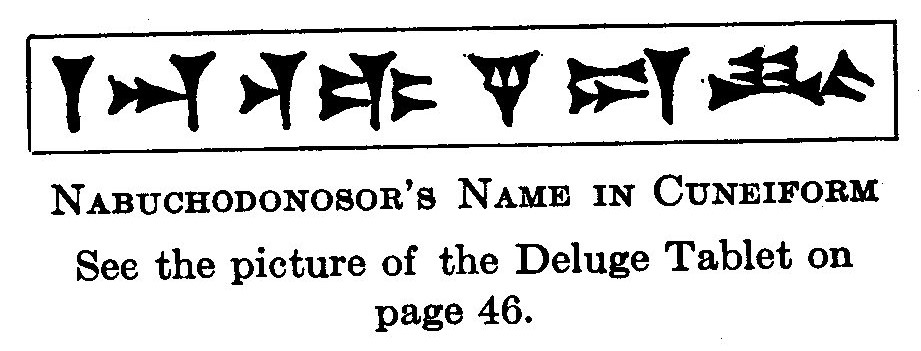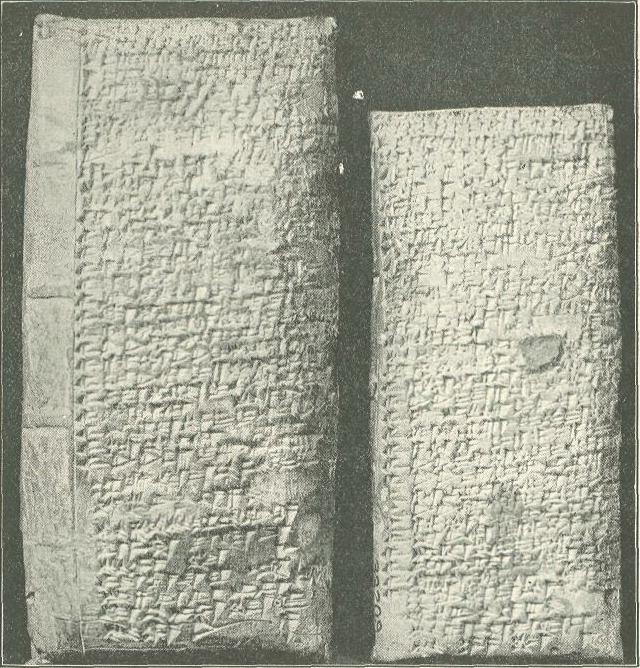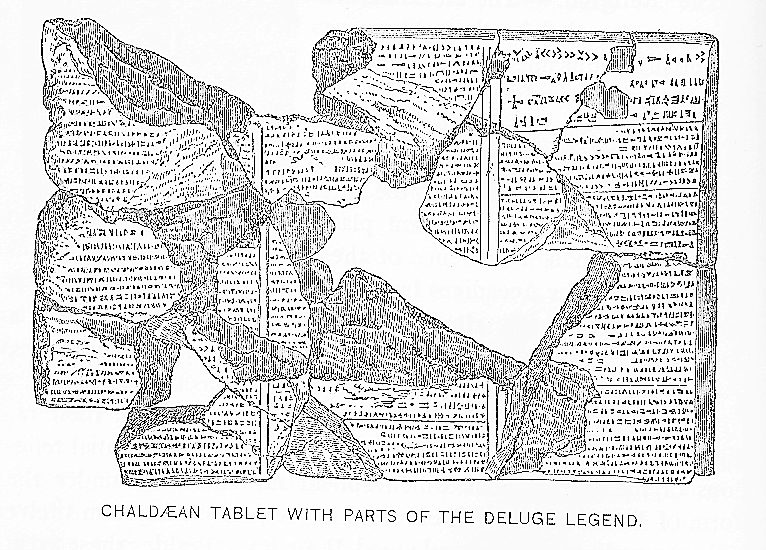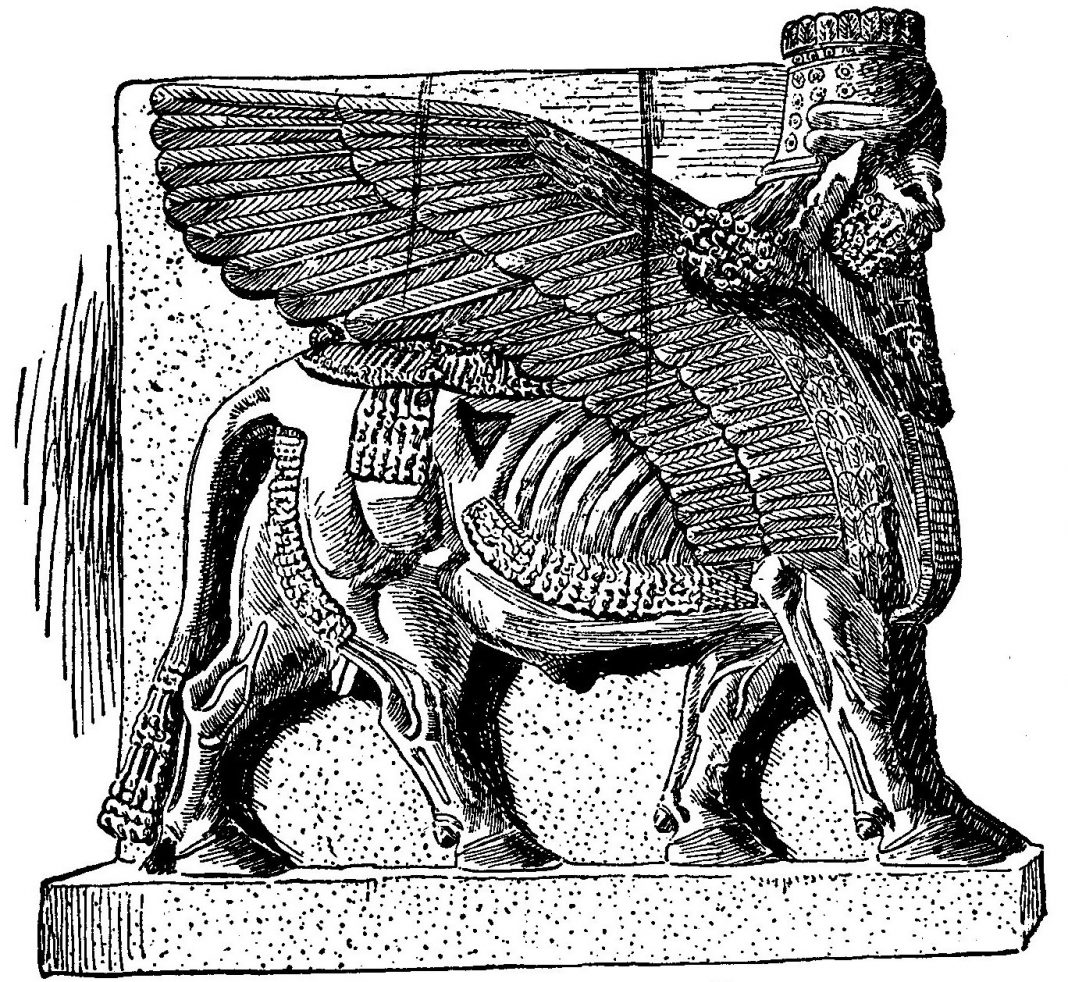The following is an excerpt (Chapter V, pages 44-52) from Ancient and Medieval History (1946) by Francis S. Betten, S.J. Although some information may be outdated, the Catholic historical perspective it provides remains pertinent. Use the link at the bottom of post to read the previous/following pages. Use Search to find specific topics or browse using the Resources tab above.
WRITING AND LITERATURE
42. Writing. — The earliest Chaldeans had a system of picture writing, not unlike the oldest form of Egyptian hieroglyphs. At first they painted the pictures on papyrus, which grew in the Euphrates as well as in the Nile. Later on they preferred to form them in tablets of soft clay, which they then baked for better preservation. Since it is difficult to make curved lines in clay, the figures more and more came to consist of straight lines, and these assumed the shape of wedges.  Hence the term cuneiform, from the Latin cuneus, wedge. Various groups of such wedges now replaced the former pictures, each group being a sort of character. At the same time the writing was gradually simplified, that is, the number of characters was greatly reduced. The cuneiform writing found its way into neighboring lands. Cuneiform inscriptions are discovered which represent the languages of other peoples and of much later times.
Hence the term cuneiform, from the Latin cuneus, wedge. Various groups of such wedges now replaced the former pictures, each group being a sort of character. At the same time the writing was gradually simplified, that is, the number of characters was greatly reduced. The cuneiform writing found its way into neighboring lands. Cuneiform inscriptions are discovered which represent the languages of other peoples and of much later times.

43. Literature. — Each of the numerous cities seems to have had its library, which, however, not only contained books, but also served as archive for the preservation of legal documents. The writings are on clay tablets, sometimes several tablets to one work, as with us the leaves of a book. (The papyrus writings have perished from the wet climate.) Each tablet had its library number stamped upon it, and the whole collection was carefully catalogued. In Babylon a library was found which consisted of some thirty thousand tablets, all of about 2700 B.C. There were grammars and dictionaries of the “dead” languages which had been once spoken in the valley, and which were studied as we study Latin; and of the foreign tongues which merchants and ambassadors had to know; and also translations of foreign books in parallel columns with the originals. (See the Deluge Tablet.)
RELIGION
44. Polytheism. — It cannot be ascertained at what exact date and in what manner polytheism began to strike root in this cradle land of mankind. Whether there were still many adorers of the true God in Chaldea when Abraham left this country for the west (§ 56), that is, about 2000 B.C., is disputed. The idolaters certainly formed an overwhelming majority.
As in the case of Egypt (§ 26), the original little states (§ 46) seem to have worshiped the true God “Who made heaven and earth” but each under its own name. When the various regions and cities came to be combined these names were taken for different gods. At one time Marduk appears as chief deity. But beside him Bel, the god of the Semites, continued to be adored. The Chaldeans also deified the powers of nature, sun, moon, thunder, etc. (They ascribed the invention of the calculation of time to the deity of the moon, as did the Egyptians.) Their idolatry was accompanied by debasing rites, in which drunkenness and the worst kinds of sensuality figured as acts of religion. There was a large number of evil spirits, which under the disguise of animals inflicted sickness and other calamities on men. But amid the wild and chaotic vagaries of polytheism there are also found some beautiful hymns, which reveal a sublime idea of a Supreme Being — no doubt the remnant of the original tradition of mankind.
45. Life after Death. — The Chaldeans did not bestow so much care upon their dead as did the Egyptians. They thought that the souls of the deceased live in or near the tomb in a state of eternal gloom. Yet, as in Egypt (§ 72), there were not wanting those who believed in a more perfect retribution: some souls were to suffer in a hell of tortures, others who knew how to secure the divine favor were to dwell amid various pleasures in the Isles of the Blest.

POLITICAL HISTORY
46. The Earliest Times. — We can say little of the long period during which small city states arose in the valley — just as in Egypt. These gradually consolidated into several larger ones. The first great ruler that stands out boldly is Sargon, King of Accad, about 2800 B.C., who succeeded in uniting under his sway the whole valley, and moreover extended his authority over all Syria to the northwest. Although this empire (H. T. F., “Empire”) fell to pieces for lack of suitable organization, it served to carry Chaldean civilization into other lands. From that time on the fashions of Chaldea were copied in Syria, its literature was studied, and commercial relations kept up the intercourse with the lands of the Euphrates and Tigris.
Ur succeeded Accad as mistress of the south. But the valley was soon overrun by new barbarians from the Arabian desert. These conquerors finally adopted thoroughly the culture of the country, and took Babylon for their chief city.
From now on the political history of the country records a rivalry between the north and the south, between Assyria and Babylonia for the ruling position in the valley. At the same time that power which held the supremacy commonly ruled over adjoining and sometimes far distant lands, thus forming an empire.
47. The first Babylonian Empire begins strictly with the rule of Hammurabi (§ 38), who lived about as many years before the birth of Christ as we live after it. In 1917 B.C. he completed the consolidation of the states of the Euphrates valley into one realm. Later he extended the rule of Babylon to the bounds of Sargon’s conquests, and with more lasting results. Ever since the name Babylon has remained a symbol of magnificence and power. During the fourth century of this empire (about 1500) it came into contact with the New Kingdom of Egypt, to which for a time it lost most of its dominions (§ 30).

48. The Assyrian Empire. — Assyria, at first a state subject to Babylonia, revolted about 1100 B.C., and under Tiglath-Pileser I became master not only of the whole valley, but also of the lands as far as the Mediterranean Sea. Under the successors of Tiglath-Pileser the extent of the empire varied, although monuments erected in far-away places show that some of them knew how to conquer. In 745 Pul, an upstart, who had been a gardener, seized the throne, and assumed the name of Tiglath- Pileser III. He extended the empire farther than it had ever been before. He removed the hereditary rulers of the conquered states and replaced them by Assyrian governors (satraps), whom he could recall at will. Thus these countries became ‘provinces instead of vassal states. This was a new invention in government, and Assyria’s chief bequest to posterity.

The next great Assyrian king was Sargon II, who carried away the Ten Tribes of Israel into captivity (722 b.c. ; see § 62) . This transplanting of a rebellious people, or at least of the better classes among them, to prevent rebellion, was a favorite device of the Assyrians. Sargon’s son, Sennacherib, is the most famous Assyrian monarch. To him is greatly due the later extent of Assyrian power. As his father had destroyed the Kingdom of Israel so he himself forced the Kingdom of Juda to pay a heavy tribute. But when he marched against it a second time, his army was mysteriously destroyed, “smitten by the angel of the Lord.”
“The Assyrian came down like the wolf on the fold,
And his cohorts were gleaming in purple and gold. . . .
Like leaves of the forest when autumn hath blown,
That host, on the morrow, lay withered and strown.” — Byron.

Sennacherib’s son, Esarhaddon, subdued Egypt in 672 B.C. (§ 31), thus bringing about the second political union of the East,
which was much more complete than the first one of several centuries earlier (§ 30). It united a much larger territory, for the Assyrians were reaching out west and east into the new regions of Asia Minor and of Media on the Plateau of Iran.
49. Fall of Assyria.— This wide rule was shortlived — happily so, for no other great empire has ever so delighted in blood. Disagreeable as it is, the student should read one of the records in which an Assyrian king exults over his fiendish cruelties. The following one is by Assur-Natsir-Pul, 850 B.C. :
“With combat and with slaughter I attacked the city and captured it. Their spoil, their goods, their oxen, and their sheep I carried away. I captured many of the soldiers alive. I cut off the hands and feet of some; I cut off the noses, the ears, and the fingers of others; the eyes of the numerous soldiers I put out. I built up a pyramid of the living and a pyramid of heads. Their young men and their maidens I burned as a holocaust.”

Against such cruelty and against the crushing Assyrian taxation, there rankled a passionate hatred in the hearts of the oppressed peoples. After twenty years of subjection, Egypt broke away. Twenty years later, Babylon followed. In 606 the new power of the Medes (§ 67), aided by Babylon, captured Nineveh itself. The Assyrian Empire disappeared, and the proud “city of blood,” which had razed so many other cities, was given over to sack and pillage.
50. The New Babylonian Empire. — Babylon had risen in many a fierce revolt during the five centuries of Assyrian dominion. A revolution in 625 was successful, and it became independent. In 606 Babylonia joined the power of the Medes in the siege and destruction of Nineveh, and these two new states shared between them what was left of old Assyria. This second Babylonian Empire lasted less than a century. Its most glorious period, 604-561, falls to the reign of Nabuchodonosor (Nebuchadnezzar). This energetic ruler checked the reviving power of Egypt, which under King Neco made another effort to extend its sway into Asia (§ 33). He destroyed rebellious Jerusalem and carried the Jews away into the Babylonian captivity (§ 64). He restored the ancient limits of the Babylonian Empire with some additions, rebuilt Babylon on a more magnificent scale, and renewed the ancient engineering works. But a few years after his death, under his son Nabonedus, Babylon fell before the rising power of the Persians (§ 68), as did Egypt a little later, and her independent kingdom was forever at an end


